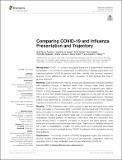Comparing COVID-19 and Influenza Presentation and Trajectory
Author(s)
Reiner Benaim, Anat; Sobel, Jonathan A.; Almog, Ronit; Lugassy, Snir; Ben Shabbat, Tsviel; Johnson, Alistair Edward William; Eytan, Danny; Behar, Joachim A.; ... Show more Show less
Downloadfmed-08-656405.pdf (1.800Mb)
Publisher with Creative Commons License
Publisher with Creative Commons License
Creative Commons Attribution
Terms of use
Metadata
Show full item recordAbstract
Background: COVID-19 is a newly recognized illness with a predominantly respiratory presentation. It is important to characterize the differences in disease presentation and trajectory between COVID-19 patients and other patients with common respiratory illnesses. These differences can enhance knowledge of pathogenesis and help in guiding treatment. Methods: Data from electronic medical records were obtained from individuals admitted with respiratory illnesses to Rambam Health Care Campus, Haifa, Israel, between October 1st, 2014 and October 1st, 2020. Four groups of patients were defined: COVID-19 (693), influenza (1,612), severe acute respiratory infection (SARI) (2,292), and Others (4,054). The variable analyzed include demographics (7), vital signs (8), lab tests (38), and comorbidities (15) from a total of 8,651 hospitalized adult patients. Statistical analysis was performed on biomarkers measured at admission and for their disease trajectory in the first 48 h of hospitalization, and on comorobidity prevalence. Results: COVID-19 patients were overall younger in age and had higher body mass index, compared to influenza and SARI. Comorbidity burden was lower in the COVID-19 group compared to influenza and SARI. Severely- and moderately-ill COVID-19 patients older than 65 years of age suffered higher rate of in-hospital mortality compared to hospitalized influenza patients. At admission, white blood cells and neutrophils were lower among COVID-19 patients compared to influenza and SARI patients, while pulse rate and lymphoctye percentage were higher. Trajectories of variables during the first 2 days of hospitalization revealed that white blood count, neutrophils percentage and glucose in blood increased among COVID-19 patients, while decreasing among other patients. Conclusions: The intrinsic virulence of COVID-19 appeared higher than influenza. In addition, several critical functions, such as immune response, coagulation, heart and respiratory function, and metabolism were uniquely affected by COVID-19.
Date issued
2021-05Department
Massachusetts Institute of Technology. Institute for Medical Engineering & ScienceJournal
Frontiers in Medicine
Publisher
Frontiers Media SA
Citation
Reiner Benaim, Anat et al. "Comparing COVID-19 and Influenza Presentation and Trajectory." Frontiers in Medicine 8 (May 2021): 656405. © 2021 Reiner Benaim et al.
Version: Final published version
ISSN
2296-858X